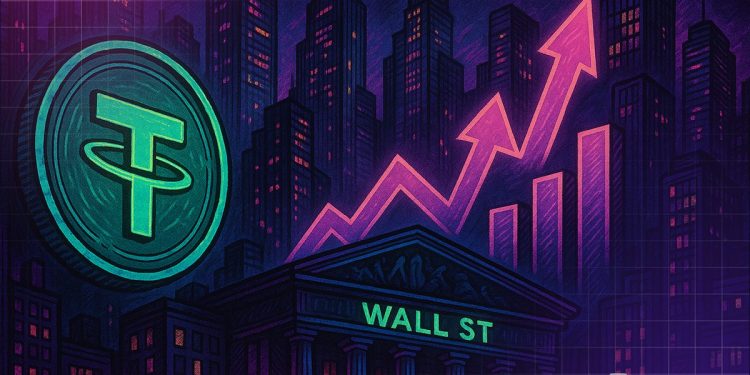Key Takeaways:
Tether, Kraken, and Circle are leading a surge in crypto IPOs and capital-raising, pulling the industry deeper into mainstream finance. Public listings force crypto firms to embrace governance, compliance, and investor accountability. With over $300 billion in circulation, stablecoins are now crucial to digital payments, particularly in countries struggling with high inflation.2025 could be a breakout year for crypto initial public offerings (IPOs) following the successful debut of stablecoin-issuer Circle on the NYSE in June.
From Tether’s reported $20 billion funding round at $500 billion valuation to Kraken’s $500 million pre-IPO raise, crypto companies’ rush into public markets is in full swing. Kraken raises the exchange’s value to $15 billion.
Analysts who spoke to Cryptonews said major capital raises and the increase in crypto firms looking to go public may prove to be a pivotal moment in merging the industry with traditional finance, or TradFi.
“The crypto IPO and fundraising wave is a statement of the actualization of crypto’s long-anticipated trajectory to becoming a core part of major global economies,” says Shawn Young, chief analyst at crypto exchange MEXC.
“By aligning with major investors and embracing public market security, crypto firms are actively bridging the gap between blockchain innovations and mainstream finance.”
On June 5, USDC issuer Circle listed on the New York Stock Exchange (NYSE) at an IPO price of $31, securing around $1.05 billion in proceeds. The company’s market debut showed strong demand for regulated crypto assets among traditional investors.
Shares of Circle soared as much as 180% to close at $88 on the first day of trading. The stock later rallied to nearly $300 before falling to $149 as of this writing. Circle’s market cap is currently at just over $34 billion.
Source: StockguideMeanwhile, Bloomberg reported that Tether is in talks with SoftBank and Ark Invest for $20 billion in funding, a deal that would put the USDT-issuer’s valuation on par with Netflix and above legacy giants like IBM and Uber.
Kraken’s $15 billion valuation places it among the most valuable private exchanges worldwide, ahead of its long-awaited IPO. Experts say crypto’s public market push shows the industry is “maturing and institutionalizing.”
Mainstreaming Crypto via IPOs
“Capital market entry provides crypto firms with both legitimacy and access to institutional capital … on a scale that allows them to pursue further development, innovation, and mainstream integration of digital assets,” said Farzam Ehsani, cofounder and CEO of crypto platform VALR.
Speaking to Cryptonews, Ehsani said it was “inevitable” that crypto would converge with traditional finance as world economies digitize and investors chase growth in blockchain infrastructure.
Crypto is generally founded on the principle of decentralization, which, in theory, implies the absence of centralized control and regulatory oversight. By contrast, TradFi is full-on control and regulatory compliance. In the past, this would have made crypto and traditional finance “incompatible,” he said.
“While concerns about centralization and innovation suppression by shareholders persist, these risks can be effectively managed through proper accountability and due diligence on investors.”
Apart from bringing liquidity, analysts say going public also opens the door for pension funds, sovereign wealth funds, and asset managers to gain exposure to crypto assets in a regulated, transparent manner.
Could Stablecoins be the New Digital Dollar?
According to MEXC chief analyst Young, the bridge between crypto and traditional finance is more visible in the stablecoin market.
Once native to crypto, stablecoins — crypto tokens pegged to a fiat currency like the U.S. dollar — are now a major part of the global financial system.
Data shows that stablecoins now represent more than $302 billion in circulation, accounting for over 1% of the U.S. M2 money supply. Citi analysts predict the figure could reach $4 trillion by 2030 under a bullish scenario.
“Stablecoin issuance and regulated digital asset exchanges are no longer reserved for the crypto niche,” Young told Cryptonews. “They’re becoming core infrastructure for the future of digital finance, particularly in emerging markets where dollar access is limited.”
Source: DefillamaIn inflation-hit economies across Africa and Latin America, stablecoins have become a lifeline for preserving value, according to Chainalysis. They are also popular with users in remittances and cross-border trade.
In Nigeria, Africa’s biggest crypto market, USDT adoption is rising faster than in USD markets. Over the last year, USDT accounted for 7% of purchases versus 5% in the dollar, Chainalysis says in a new report.
“This reflects the growing role of stablecoins as a dollar substitute in economies where the official exchange rate diverges from the black market rate,” says the report. “Citizens increasingly rely on crypto rails for informal forex access, payments, and savings.”
Young says the growth hints at a future where the dollar could circulate just as easily through decentralized rails as through traditional ones. And that’s what gives the current cryptocurrency IPO wave its weight.
“Access to capital markets can drive innovation, allowing companies like Tether to expand into established markets such as the US via the GENIUS Act while maintaining strong ties to emerging markets,” he said, adding:
“Kraken can use the capital infusion to fund technological upgrades, research, expansion into new marketsand potential strategic acquisitions that will further cement crypto’s presence in regulated finance.”
Crypto IPOs: Legal and Regulatory Hurdles
Going public provides huge upside, but it comes with challenges. Lionel Iruk, senior advisor to Nav Markets and managing partner at Empire Legal, said crypto companies entering the capital markets are stepping into a world of legal, operational, and governance obligations.
“The 2025 crypto IPO and fundraising surge, from Gemini’s Nasdaq debut to Circle’s $33 billion market cap and Tether and Kraken’s potential raises, … is not merely about capital raising,” Iruk tells Cryptonews.
“It reflects the industry’s maturation, [to the point where] governance, transparency, utility, and regulatory alignment are now as critical as growth metrics in attracting top-tier institutional investors.”
Public companies are subject to quarterly disclosures, board oversight, and jurisdictional securities laws that crypto startups have historically resisted.
Cryptocurrency companies could also be exposed to the same market pressures that plague traditional corporations, such as earnings anxiety, stock market volatility, and the whims of shareholder sentiment.
Iruk said it means exchanges and issuers will need to strike “a balance between innovation and compliance, ensuring that regulatory oversight doesn’t stifle growth or decentralization.”But he believes that the benefits far outweigh the risks.
“Legal teams will be very critical in shaping strategies and designing frameworks that meet investor expectations while protecting corporate interests and preserving market confidence.”
MEXC’s Young framed the risks as growing pains rather than red flags. “Public market scrutiny exposes firms to financial reporting obligations, market sentiment, and regulatory pressures,” he says.
“However, these risks are outweighed by the sheer scale of the upside of successful integration into the capital market … [that] ultimately lay the foundation for a more resilient market and tempered volatility.”
Young expects that the next 12-18 months could determine whether crypto’s integration with Wall Street “will be incremental for the industry or all-around transformative for digital finance.”
The post Gemini Debut and $15B Kraken Valuation Show Crypto IPO Rush to Wall Street appeared first on Cryptonews.













